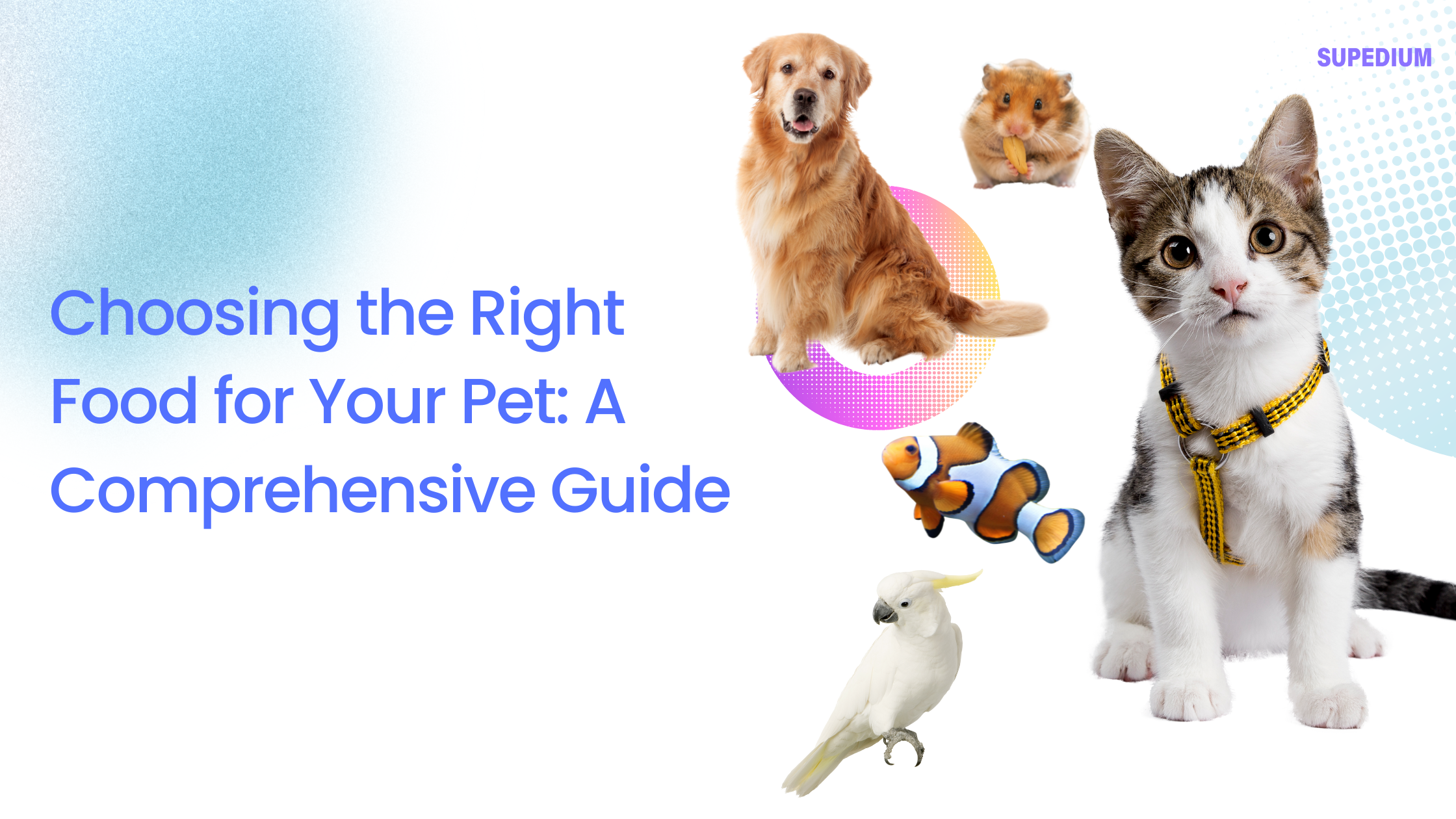Table of Contents
![]()
Introduction
Choosing the right food for your pet is crucial for maintaining their health and well-being. Proper nutrition impacts everything from energy levels to longevity, and a balanced diet helps prevent chronic diseases and conditions. Each pet, whether a dog, cat, or another animal, has unique dietary needs that are influenced by factors such as age, size, breed, and activity level. This article provides a comprehensive guide to selecting the best food for your pet, ensuring they receive the right balance of nutrients to thrive.
Understanding Pet Nutritional Requirements
To choose the right food, it’s essential to understand your pet’s nutritional needs. Pet diets must provide a balanced mix of nutrients, including proteins, carbohydrates, fats, vitamins, and minerals.
1. Basic Nutrients
- Proteins: Proteins are crucial for growth, repair, and maintaining muscle mass. High-quality sources include meat, fish, and some plant-based options. Pets, especially dogs and cats, require animal-based proteins for optimal health.
- Carbohydrates: Carbohydrates provide a primary energy source and are found in grains, vegetables, and fruits. While not as critical as proteins, they support overall energy levels and digestive health.
- Fats: Fats are vital for energy, skin health, and a shiny coat. They include saturated and unsaturated fats. Essential fatty acids, like omega-3 and omega-6, support brain function and reduce inflammation.
- Vitamins and Minerals: Vitamins (A, D, E, K, and B-complex) and minerals (calcium, phosphorus, potassium) play various roles, including immune support, bone health, and nerve function. Ensuring your pet’s food includes a balanced mix of these nutrients is key to their health.
2. Special Considerations
- Age-specific Needs: Puppies and kittens require food rich in proteins and calories for growth, while older pets may need diets that support joint health and lower calorie intake to prevent obesity.
- Breed-specific Needs: Different breeds have varying needs. For example, large breeds may benefit from joint-supporting supplements, while small breeds may need more calorie-dense food.
- Weight Management: Managing your pet’s weight is crucial. Overweight pets may require reduced-calorie diets, while underweight pets might need higher-calorie foods to gain weight.
Types of Pet Food
Selecting the right type of food involves understanding the different options available and their respective benefits and drawbacks.
1. Commercial Pet Foods
- Dry Kibble: This is the most common type of pet food. It is convenient, helps with dental health by reducing tartar buildup, and is generally less expensive. However, it contains less moisture, which can be a concern for pets with certain health issues.
- Canned/Wet Food: Canned food has a higher moisture content, which can be beneficial for pets with urinary or kidney problems. It’s often more palatable but can be more expensive and has a shorter shelf life.
- Semi-Moist Food: Semi-moist foods are convenient and appealing to many pets. However, they often contain high sugar levels and artificial preservatives, which are less ideal for long-term health.
2. Specialty Pet Foods
- Prescription Diets: These are formulated for pets with specific health conditions like kidney disease or allergies. They should only be used under veterinary guidance.
- Grain-Free and Limited Ingredient Diets: These diets are designed for pets with food sensitivities or allergies. They eliminate grains or minimize the number of ingredients to reduce the risk of allergic reactions.
- Organic and Natural Foods: These foods contain no artificial additives and often use higher-quality ingredients. They can be beneficial for overall health but may come at a higher cost.
Evaluating Pet Food Quality
To ensure you’re choosing high-quality food, it’s important to evaluate labels and brand reputations.
1. Reading Pet Food Labels
- Ingredient List: Look for named meat sources as the first ingredient (e.g., chicken, beef) rather than generic terms like “meat by-products.” Avoid foods with fillers like corn or soy and artificial preservatives.
- Nutritional Adequacy Statements: Check for statements from organizations like AAFCO (Association of American Feed Control Officials) that indicate the food meets established nutritional standards.
- Guaranteed Analysis: This section provides information on the percentage of protein, fat, fiber, and moisture in the food. It helps ensure the food meets your pet’s dietary needs.
2. Brand Reputation and Recalls
Research the brand’s history and reputation. Reputable brands should have a track record of quality and safety. Check for recent recalls to ensure the food hasn’t been subject to safety issues.
Customizing Your Pet’s Diet
1. Consulting with a Veterinarian
Consulting a veterinarian is crucial for personalized dietary advice. Vets can help address specific health concerns, recommend suitable food types, and adjust diets based on your pet’s individual needs.
2. Transitioning to New Food
When changing your pet’s food, do so gradually over a period of 7-10 days. Mix increasing amounts of the new food with decreasing amounts of the old food to avoid digestive upset. Monitor your pet for any adverse reactions during the transition.
Homemade and Raw Diets
1. Benefits and Risks
Homemade and raw diets offer control over ingredient quality and can be tailored to your pet’s needs. However, they come with risks, such as potential nutritional imbalances and contamination. It’s important to consult a pet nutritionist to ensure a balanced diet.
2. Guidelines for Homemade Diets
If you opt for homemade diets, ensure they are well-balanced with all essential nutrients. Follow safe food preparation practices to avoid contamination and work with a nutritionist to create a balanced meal plan.
Special Considerations
1. Allergies and Sensitivities
If your pet shows signs of food allergies, such as itching or digestive issues, consider hypoallergenic or limited ingredient diets. Identifying and eliminating allergens can significantly improve your pet’s quality of life.
2. Supplementing Diet
Some pets may benefit from dietary supplements like omega fatty acids or probiotics. Consult with your vet before adding supplements to ensure they are appropriate for your pet’s needs.
Conclusion
Choosing the right food for your pet involves understanding their unique nutritional needs, evaluating food options, and consulting with professionals. A well-balanced diet contributes significantly to your pet’s overall health, longevity, and happiness. Regularly reviewing and adjusting your pet’s diet, based on their changing needs and health conditions, will help ensure they receive the best care possible.
Share This





Be the first to comment